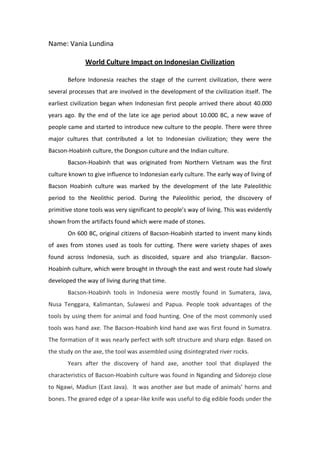World culture impact on indonesian civilization
- 1. Name: Vania Lundina<br />World Culture Impact on Indonesian Civilization<br />Before Indonesia reaches the stage of the current civilization, there were several processes that are involved in the development of the civilization itself. The earliest civilization began when Indonesian first people arrived there about 40.000 years ago. By the end of the late ice age period about 10.000 BC, a new wave of people came and started to introduce new culture to the people. There were three major cultures that contributed a lot to Indonesian civilization; they were the Bacson-Hoabinh culture, the Dongson culture and the Indian culture.<br />Bacson-Hoabinh that was originated from Northern Vietnam was the first culture known to give influence to Indonesian early culture. The early way of living of Bacson Hoabinh culture was marked by the development of the late Paleolithic period to the Neolithic period. During the Paleolithic period, the discovery of primitive stone tools was very significant to people’s way of living. This was evidently shown from the artifacts found which were made of stones.<br />On 600 BC, original citizens of Bacson-Hoabinh started to invent many kinds of axes from stones used as tools for cutting. There were variety shapes of axes found across Indonesia, such as discoided, square and also triangular. Bacson-Hoabinh culture, which were brought in through the east and west route had slowly developed the way of living during that time.<br />Bacson-Hoabinh tools in Indonesia were mostly found in Sumatera, Java, Nusa Tenggara, Kalimantan, Sulawesi and Papua. People took advantages of the tools by using them for animal and food hunting. One of the most commonly used tools was hand axe. The Bacson-Hoabinh kind hand axe was first found in Sumatra. The formation of it was nearly perfect with soft structure and sharp edge. Based on the study on the axe, the tool was assembled using disintegrated river rocks.<br />Years after the discovery of hand axe, another tool that displayed the characteristics of Bacson-Hoabinh culture was found in Nganding and Sidorejo close to Ngawi, Madiun (East Java). It was another axe but made of animals’ horns and bones. The geared edge of a spear-like knife was useful to dig edible foods under the ground or to catch fishes. The formation of this axe was a bit developed than the first hand axe found in Sumatra. There was also a very useful tool called flakes found in many places including Sangiran, Pacitan, Gombong, Parigi, Jampang Kulon, Ngandong, Lahat, Batturing, Cabbenge, Wanga, Soa and Mangeruda. Most flakes were made using fine rocks like Calsedon. Its functions included cutting and slicing. <br />The distribution of Sumatra hand axe (later called Sumatralith) and short axe were linked to a place called Tonkin in Indochina where it was known as the center of prehistoric culture of Bacson-Hoabinh or Mesolithic tools in South-East Asia. <br />By about 2.500 BC, Indonesian people learned how to grow crops, including rice. This activity of cultivating was developed around the 700 BC when people had learned to make bronze and iron products. The metal culture was brought in by Dongson culture, as well as the introduction of wet rice cultivation system. Dongson culture was originated in a place called Dongson in Vietnam, which is located around Ma River. <br />As the bronze culture former of South-East Asia, Dongson culture also influenced the development of Indonesian culture. Metal products made of bronze and irons were found in many parts of Indonesia. It can be seen from a metal product called nekara or drum. Approximately, there were 56 nekara found throughout Indonesia. They were mostly found in Sumatra, Java and South Maluku). Nekara is used in ritual ceremonies such as calling the rain or for worshipping. A smaller nekara called Moko was also found in Pulau Alor.<br />Metal products from Dongson culture were also presented through products like statues, households, farming tools and jewelries. Through some analysis, it is found that the Austronesian brought in Dongson culture to Indonesia through the West (Semenanjung Malaya). The existence of Dongson culture in Indonesia had successfully classified Indonesian culture into two different phases: the proto Malay (primitive Dayak) and the deutero Malay (Bali and Lombok). <br />However, the main influence of Dongson culture can also be seen on the spiritual culture influence. By the guidance from Dongson culture, people of Indonesia were able to produce a boat and they had enough knowledge on farming. The spiritual culture were also developed from the beliefs of people on animism or astrology/horoscope.<br />On the year 1-5, trading activities between the South East Asian countries began to grow. Indonesia became the meeting point of the traders because of its strategic location among the South East Asian countries. Indonesia began to join the trades and interacted with other countries. India, as one of the traders seemed to attract Indonesia with its astonishing culture.<br />India’s culture soon affected the living style of Indonesian people. It is obviously shown in the distribution of religions like Hinduism and Buddhism across the country. From the similarities of Indonesian culture and Indian culture during that time, we could see that India brought the most influences on Indonesian culture. At the same time, it led Indonesia to the newest or more advanced civilization.<br />India introduced a lot of new way of living for Indonesian people. Some cultures influenced by India include the kingdom system of ruling that can be seen from Kutai and Tarumanegara kingdoms, in arts, language and also social life. From the inscriptions found in the old kingdoms of Indonesia, it is assumed that Indonesian people had known Sanskrit language and Pallawa letters for a long time. Some evidences of this influence can be seen from the discoveries of Buddha statue in Sulawesi, east Java and South Sumatra. <br />Eventually, our country is settled with the most developed culture that lasts until today. There are still chances that our culture would be influenced by the more modern culture that people find them interesting. <br />


